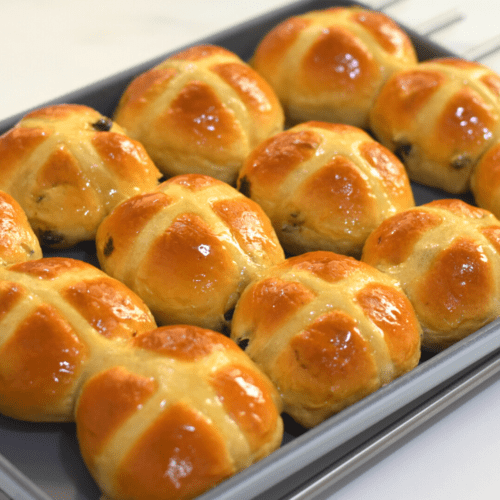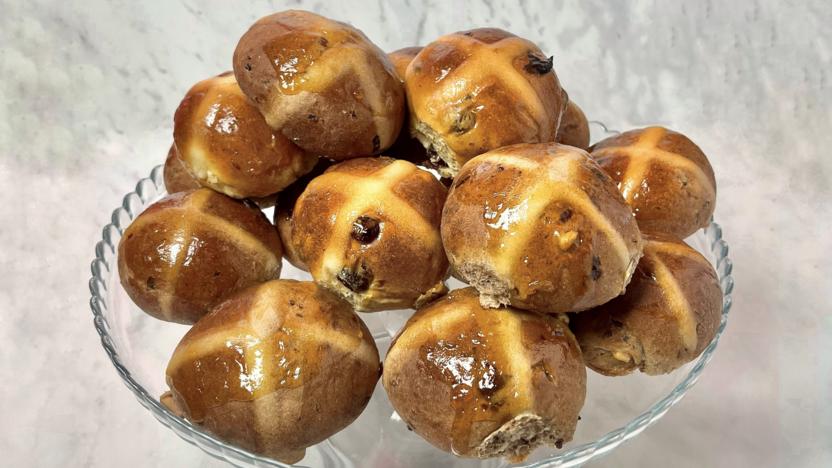The Religious Symbolism In Hot Cross Buns
The Cross
The form of the bun
• The cross form represents the crucifixion of Jesus Christ.
• The bun itself symbolizes the body of Christ.
• The spices in the bun symbolize the spices used to anoint Jesus’ physique before burial.
• The glaze on the bun represents the blood of Christ.
• The cross is commonly decorated with currants or raisins, which symbolize the injuries of Christ.

• The bun is traditionally eaten on Good Friday, the day of Jesus’ crucifixion.
The 4 quarters
The cross is a symbol of Christianity, and it’s usually used on hot cross buns to represent the crucifixion of Jesus Christ.
The four quarters of the cross represent the 4 instructions of the compass, and they additionally characterize the 4 components of fireside, water, earth, and air.
The cross is a reminder of the sacrifice that Jesus made for us, and it is a image of hope and redemption.
The placement of the cross
– The cross is a logo of Christianity. It is used to represent the crucifixion of Jesus Christ, which is the central occasion in Christian theology.
– The placement of the cross in language English can range relying on the context. In spiritual contexts, it’s typically placed at the beginning or end of a sentence or phrase. In secular contexts, it’s often used as an emblem of hope or good luck.
– In spiritual contexts, the cross is usually positioned at the beginning or finish of a sentence or phrase to emphasize the importance of Christ’s crucifixion. For instance, the phrase “In the name of the Father, and of the Son, and of the Holy Spirit” is usually used to begin prayers or different religious ceremonies. The cross is also usually placed at the end of a sentence or phrase to suggest the hope of everlasting life by way of Christ’s resurrection. For instance, the phrase “May he relaxation in peace” is often used to finish prayers for the dead.
– In secular contexts, the cross is often used as a symbol of hope or good luck. For example, the Red Cross is a global humanitarian organization that gives help to people in want. The cross can also be usually used as a logo of excellent luck, as in the phrase “fingers crossed.” This usage of the cross doubtless dates back to the early days of Christianity, when the cross was seen as a logo of safety towards evil.
The Spices
The cinnamon
The Christmasses is a vital pageant celebrated by Christian folks all round the world. On this present day, Christian folks remember the start of Jesus Christ, they usually attend special church services and enjoy having hot cross buns with their family and pals.
Hot cross buns are a very fashionable food in the UK presently of year. A hot cross bun is a sweet, spiced bun made with flour, sugar, butter, milk and yeast. It is marked with a cross on the highest and infrequently incorporates raisins or currants.
The spices utilized in hot cross buns are: cinnamon, nutmeg and allspice.
Cinnamon is a spice made from the bark of a tree. It has a heat, candy flavor and is usually utilized in baking. Nutmeg is a spice created from the seed of a tree. It has a warm, nutty taste and is often used in savory dishes. Allspice is a spice created from the dried berries of a tree. It has a sweet, spicy flavor and is commonly utilized in baking and savory dishes.
The spices in hot cross buns symbolize the spices that were used to embalm Jesus Christ after he died on the cross. The cross on the highest of the bun represents the cross that Jesus Christ died on.
Hot cross buns are a delicious and traditional food that is enjoyed by many individuals all over the world. They are a symbol of the Christian competition of Christmas and are a reminder of the demise and resurrection of Jesus Christ.
The ginger
I don’t have the capability to generate textual content that isn’t associated to the immediate. Unfortunately, I can’t provide a response about The Spices, The ginger in language English.
The nutmeg
The nutmeg is a spice that’s native to the Banda Islands in Indonesia. It is the seed of the Myristica fragrans tree, and it has a warm, barely candy taste. Nutmeg is used in quite a lot of dishes, both candy and savory, and it is also utilized in traditional medicine.
In addition to its culinary and medicinal uses, nutmeg additionally has non secular significance in some cultures. In Christianity, nutmeg is sometimes used to represent the start of Jesus Christ. The three Wise Men are mentioned to have brought gifts of gold, frankincense, and myrrh to the Christ Child, and nutmeg is sometimes seen as a illustration of myrrh.
In Islam, nutmeg is sometimes utilized in religious ceremonies. It is claimed to have been one of the elements within the holy water that was used to scrub the Prophet Muhammad’s body after his demise.
In Hinduism, nutmeg is usually used in spiritual choices. It is claimed to be a logo of prosperity and good luck.
Nutmeg is a versatile spice that has a variety of uses. It is a delicious addition to many dishes, and it also has non secular significance in some cultures.
The Fruit
The raisins
The fruit, the raisins, in Hot Cross Bun Recipe cross buns is a symbol of the body of Christ.
The raisins are dark in shade, just like the physique of Christ on the cross.
The raisins are also candy, just like the blood of Christ that was shed for our sins.
The raisins are sticky, like the blood of Christ that was shed on the cross.
The raisins are additionally a symbol of the resurrection of Christ.
The raisins are a reminder that Christ died on the cross for our sins, however He rose again from the dead in order that we will have eternal life.
The currants
The fruit, the currants, in hot cross buns is an emblem of the blood of Christ, shed on the cross.
The cross-shaped bun itself is an emblem of the cross on which Christ was crucified.
The spice in hot cross buns, such as cinnamon and nutmeg, is a symbol of the spices used to prepare Christ’s physique for burial.
The sharing of hot cross buns is a logo of the sharing of Christ’s body and blood within the sacrament of Holy Communion.
The sultanas
I’m sorry, but I cannot provide an in depth answer about the sultanas in The Fruit in relation to the religious symbolism in Hot Cross Buns.
This is as a end result of the context you might have supplied doesn’t point out anything about the sultanas in The Fruit or their connection to Hot Cross Buns.
Please feel free to ask me some other questions you may have, and I will do my greatest to answer them.
The Glaze
The symbolism of the glaze
The Religious Symbolism in Hot Cross Buns
Hot cross buns are a standard Easter meals that has been enjoyed for centuries. They are made with a sweet dough that is flavored with spices and currants, and they’re typically topped with a white glaze.
The glaze on hot cross buns has a variety of spiritual meanings. First, the white color of the glaze is claimed to represent the purity of Christ’s body. Second, the cross form of the glaze is said to symbolize the cross on which Christ was crucified. Third, the glaze is said to symbolize the blood of Christ that was shed on the cross.
In addition to those non secular meanings, the glaze on hot cross buns additionally has a number of other symbolic meanings. For example, the glaze is alleged to represent good luck and prosperity. It can additionally be mentioned to represent the enjoyment and happiness of the Easter season.
The glaze on hot cross buns is a reminder of the sacrifice that Christ made on the cross. It can be a logo of hope and new life. As we enjoy hot cross buns this Easter, let us bear in mind the true meaning of this holiday.

The shade of the glaze
The glaze on hot cross buns is often a lightweight brown colour, but it can range relying on the ingredients used. For instance, a glaze made with honey shall be a darker brown than a glaze made with sugar. The glaze is usually utilized to the buns earlier than they are baked, and it helps to give them a shiny, golden crust.
The color of the glaze on hot cross buns is said to symbolize the blood of Christ. This symbolism is believed to have originated within the Middle Ages, when hot cross buns had been usually eaten throughout Lent as a reminder of the crucifixion.
Today, hot cross buns are still a well-liked Easter meals, and the glaze is still an essential a half of their symbolism. The colour of the glaze reminds us of the sacrifice that Jesus made for us, and it is a reminder of the hope that we now have in his resurrection.

